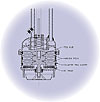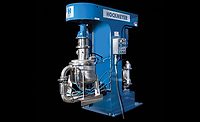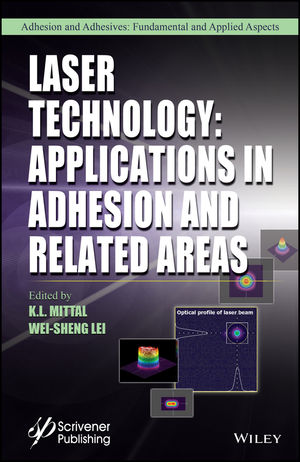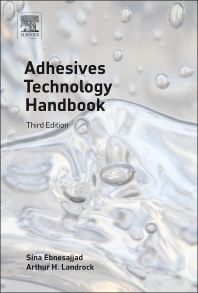Faster Nano Dispersions Using Immersion Mill Technology
Nano milling is becoming more and more practical as we
learn the idiosyncrasies and demands of the process.

The second challenge was keeping the media in the grind chamber from escaping through the intake draft tube. Floatation, as well as pressure increases in the screen area, can cause the media field to expand into the void volume area within the chamber and cause the media to escape through the upper intake draft tube.
The third challenge was to prevent media from leaking through the machined tolerances between the bushing supporting the shaft and the shaft itself as it passes through the bottom screen of the mill chamber and connects to the suction propeller below it.
And the last challenge was to substantially increase the activity in the media field to allow rapid feedstock pass-thru while simultaneously accelerating the number of contacts per unit of time.

The first challenge was overcome by ensuring that the screens were consistent in slot size. A technically improved and precise manufacturing process at Hockmeyer eliminated screen warping.
The Intake Upper Draft Tube
Adding an auger to the upper draft tube of the mill chamber solved the second challenge. The auger plays several roles. It provides a consistent feed of material into the mill chamber during the startup process and prevents the media field from floating during the initial immersion of the mill head into the batch.
The auger forces large agglomerates to stay in the milling chamber along with the media until they are small enough to pass through the screen. In this instance, the auger acts as a governor by allowing material in the upper draft tube to slip along the auger and not over pressurize the mill chamber. As a result of this governor affect, the media field does not expand and media loss through the upper draft tube is eliminated.
The flow rate of oversized agglomerates is controlled by the pumping rate of the auger. The disintegration of the agglomerates is controlled by the intensity of the bead field and the dwell time within the basket. Pumping rates can go up or down at any given speed by selection of the appropriately pitched auger. This allows for very high energy, hyperactive flow fields using very small media. Small media is considered to be at or below 0.3 mm diameter.
The Support Bushing
The third obstacle was eliminated by the development of the HCPN centrifugal peg hub. The hub was designed to generate sufficient centrifugal force to keep the media field away from the support bushing in the bottom of the screen.
Increasing Media Oscillation Frequency
As the size of media is reduced the number of contact points increases. The amount of void space between the beads becomes smaller, reducing the ability of agglomerates to “hide” between the contact points. However, this also results in flow field lethargy. The bead field begins to act more and more as a solid and becomes almost impenetrable by most slurries. The result is hydraulic packing and plugged screens. Fluidization of the bead field increases the ability of the slurry to flow thru it. The higher the degree of fluidization, the faster the slurry makes its pass through the mill and returns for additional passes. The more passes made within a given time period, the faster the dispersion progresses. Hyperactivity of the media field makes aggressive fluidization possible. It is accomplished by dramatically increasing the number of contacts between the media and the feedstock per unit of time, thus allowing rapid pass thru with high frequency contacts.
These pigments in some cases, especially the yellow press cake, had agglomerates 1/2 inch in diameter when the milling started, and in a matter of two hours the entire particle size distribution was below the visible wavelength of light.
The increase in velocity of individual beads is accomplished by increasing the speed of the impeller assembly. However, it is the counter-peg insert assembly that makes the higher impeller speeds functionally operative. Without it, the higher speeds would merely create centrifuging of the bead field with little effect on milling performance. The combination of these two improvements simultaneously increases flow field activity, bringing it toward the hyperactivity range; the higher the speed, the greater the number of contacts per unit of time and the greater the feedstock throughput.
As the media size decreases, the tip speed increases to compensate for the loss of mass of the individual beads. Although higher speeds are required to compensate for the reduced mass of small beads, the particles being ground are also smaller, so the kinetic energy per bead does not have to match that of large media.
The net effect is still a higher amount of horsepower per liter of small beads compared to an equal volume of larger beads. As beads decrease in size they will continue to break down smaller particles using proportionally less power per bead; the number of beads per liter increases dramatically. The increase in horsepower/liter of beads will manifest itself in higher heat in the bead/slurry field. It will also reduce the amount of time required to reach a given standard, assuming temperature can be controlled within the tolerance range of the slurry. Here is an example based upon power input being equal to power output. The design of the HCPN mill creates a more uniform power distribution to the bead field thus allowing more power per bead without the problems associated with hydraulic packing.
Theoretically, to arrive at the same power input/bead on the smaller beads, the horsepower input per liter of beads would have to increase by a multiple commensurate with 2.8 times the velocity increase. However, as the relative mass between the bead and the agglomerate decreases, so does the average power input required per bead to break the smaller agglomerates. Although higher peg tip speeds will clearly require more horsepower, a number of variables will affect the actual power needed to grind a particular product. These variables include viscosity, rheology, specific gravity, bead size and the types of impellers used. As a general statement, based on Hockmeyer’s laboratory tests to date, a nano immersion mill with small (less than 0.8 mm) media will require two to three times the horsepower of a conventional counter peg mill using large (0.8 mm and above) media. What prevents the seemingly logical outcome of ongoing deagglomeration is the reduction in flow field activity or bead contact per unit of time. Much higher levels of media activity are required to prevent stagnation of the slurry within the flow field and continue the deagglomeration process. Without this hyperactivity, the process will slow dramatically and further improvement becomes long and arduous. The additional power input via higher average peg speeds is required to maintain the hyperactivity in what would otherwise become a lethargic and highly obstructed flow field with little or no throughput of the feedstock.
Once the smaller beads have reached equilibrium with the feedstock where the beads are approximately 1,000 times larger than the particles of the feedstock, further particle size reduction will slow to its least efficient level. To continue the particle size reduction, smaller media is required. However, our testing of higher peg speeds without changing media size has shown significantly improved performance extending to smaller particle sizes than those generated by the traditionally lower peg speeds.
If bead diameter remains the same but kinetic energy is increased through peg speed, the resulting higher oscillation frequency causes the dispersion to progress further. More frequent collisions coupled with higher relative power/bead compensate for not reducing bead size. Although higher frequency and throughput are of great value, they are not a panacea and will reach a point where bead size must again be reduced for further improvement of the dispersion.
Earlier in this paper a comment was made on how the traditional recommendation of bead diameter to agglomerate diameter ratio of 10 to 1 can be inverted using new technology. Raising and distributing the input horsepower per liter of beads made the process work because of the proportional increase in the amount of energy put into each bead. Without this power distribution addition, inversion of the ratio would not have been possible and the beads would have been unable to overcome the much larger mass they were attacking.

Utilizing this type of performance from the standard immersion mill and coupling it with the ability to run very small media and eliminate cascade milling in many instances, the HCPN has proven to be a substantial step forward in processing technology.


The Challenge
The first challenge was being able to consistently manufacture a screening device with highly accurate slot spacing that prevents the escape of the very small media from the mill. When using media at and below 0.3 mm, screen slots have to be consistent enough to ensure there are none larger than the appropriate fraction of the media size. This prevents media passage through the screen while simultaneously allowing for rapid passage of the feedstock through the screen. Additionally, the total open area of the screen must accommodate the rapid throughput from a hyperactive media field.The second challenge was keeping the media in the grind chamber from escaping through the intake draft tube. Floatation, as well as pressure increases in the screen area, can cause the media field to expand into the void volume area within the chamber and cause the media to escape through the upper intake draft tube.
The third challenge was to prevent media from leaking through the machined tolerances between the bushing supporting the shaft and the shaft itself as it passes through the bottom screen of the mill chamber and connects to the suction propeller below it.
And the last challenge was to substantially increase the activity in the media field to allow rapid feedstock pass-thru while simultaneously accelerating the number of contacts per unit of time.

Addressing the Challenges
The ScreensThe first challenge was overcome by ensuring that the screens were consistent in slot size. A technically improved and precise manufacturing process at Hockmeyer eliminated screen warping.
The Intake Upper Draft Tube
Adding an auger to the upper draft tube of the mill chamber solved the second challenge. The auger plays several roles. It provides a consistent feed of material into the mill chamber during the startup process and prevents the media field from floating during the initial immersion of the mill head into the batch.
The auger forces large agglomerates to stay in the milling chamber along with the media until they are small enough to pass through the screen. In this instance, the auger acts as a governor by allowing material in the upper draft tube to slip along the auger and not over pressurize the mill chamber. As a result of this governor affect, the media field does not expand and media loss through the upper draft tube is eliminated.
The flow rate of oversized agglomerates is controlled by the pumping rate of the auger. The disintegration of the agglomerates is controlled by the intensity of the bead field and the dwell time within the basket. Pumping rates can go up or down at any given speed by selection of the appropriately pitched auger. This allows for very high energy, hyperactive flow fields using very small media. Small media is considered to be at or below 0.3 mm diameter.
The Support Bushing
The third obstacle was eliminated by the development of the HCPN centrifugal peg hub. The hub was designed to generate sufficient centrifugal force to keep the media field away from the support bushing in the bottom of the screen.
Increasing Media Oscillation Frequency
As the size of media is reduced the number of contact points increases. The amount of void space between the beads becomes smaller, reducing the ability of agglomerates to “hide” between the contact points. However, this also results in flow field lethargy. The bead field begins to act more and more as a solid and becomes almost impenetrable by most slurries. The result is hydraulic packing and plugged screens. Fluidization of the bead field increases the ability of the slurry to flow thru it. The higher the degree of fluidization, the faster the slurry makes its pass through the mill and returns for additional passes. The more passes made within a given time period, the faster the dispersion progresses. Hyperactivity of the media field makes aggressive fluidization possible. It is accomplished by dramatically increasing the number of contacts between the media and the feedstock per unit of time, thus allowing rapid pass thru with high frequency contacts.
Cascade Milling No Longer Required
Hockmeyer developed a design that enables the HCPN mill to take a pre-dispersion to a nano dispersion without plugging the screen. The new HCPN has produced nano dispersions of methol violet, rubine red, ultra-transparent yellow press cake, phthalo blue press cake, crude blue and many other hard-to-disperse pigments straight from high-speed disperser pre-mix to a nano dispersion in a very short time using 0.8 mm media. No larger media pre-milling was necessary. The conventional wisdom of the need to use media 10 times larger than the largest agglomerate has gone the way of the buggy whip. The reason: Substantially higher power distribution to the bead field, discussed in more detail further on in this paper.These pigments in some cases, especially the yellow press cake, had agglomerates 1/2 inch in diameter when the milling started, and in a matter of two hours the entire particle size distribution was below the visible wavelength of light.
No Stagnation
When dealing with media small enough to produce a nano dispersion there were other issues in addition to containment that needed to be addressed. For example, the media in the mill chamber must not stagnate at any time in any area. Larger conventional media (above 0.3mm) is not usually a problem. However, smaller media presents many challenges. As media size decreases, hyperactivity of the flow field becomes paramount.Kinetic Energy Distribution in a Hyperactive Bead Field
As media gets smaller the mass of individual beads decreases. If the objective is to impact the agglomerates with the same amount of energy generated by the larger media, an increase in velocity is necessary. The kinetic energy of a particle equals one half the particle’s mass times the square of its velocity. Beads are essentially spherical. The volume (and therefore the mass) of a sphere varies with the cube of its radius. So, a small bead 1⁄2 the radius of a larger bead will have 1/8th the mass of the larger bead. Because kinetic energy varies with the square of the velocity, the net result is the smaller bead will need 2.8 times the velocity to have the same kinetic energy as the larger bead.The increase in velocity of individual beads is accomplished by increasing the speed of the impeller assembly. However, it is the counter-peg insert assembly that makes the higher impeller speeds functionally operative. Without it, the higher speeds would merely create centrifuging of the bead field with little effect on milling performance. The combination of these two improvements simultaneously increases flow field activity, bringing it toward the hyperactivity range; the higher the speed, the greater the number of contacts per unit of time and the greater the feedstock throughput.
As the media size decreases, the tip speed increases to compensate for the loss of mass of the individual beads. Although higher speeds are required to compensate for the reduced mass of small beads, the particles being ground are also smaller, so the kinetic energy per bead does not have to match that of large media.
The net effect is still a higher amount of horsepower per liter of small beads compared to an equal volume of larger beads. As beads decrease in size they will continue to break down smaller particles using proportionally less power per bead; the number of beads per liter increases dramatically. The increase in horsepower/liter of beads will manifest itself in higher heat in the bead/slurry field. It will also reduce the amount of time required to reach a given standard, assuming temperature can be controlled within the tolerance range of the slurry. Here is an example based upon power input being equal to power output. The design of the HCPN mill creates a more uniform power distribution to the bead field thus allowing more power per bead without the problems associated with hydraulic packing.
Theoretically, to arrive at the same power input/bead on the smaller beads, the horsepower input per liter of beads would have to increase by a multiple commensurate with 2.8 times the velocity increase. However, as the relative mass between the bead and the agglomerate decreases, so does the average power input required per bead to break the smaller agglomerates. Although higher peg tip speeds will clearly require more horsepower, a number of variables will affect the actual power needed to grind a particular product. These variables include viscosity, rheology, specific gravity, bead size and the types of impellers used. As a general statement, based on Hockmeyer’s laboratory tests to date, a nano immersion mill with small (less than 0.8 mm) media will require two to three times the horsepower of a conventional counter peg mill using large (0.8 mm and above) media. What prevents the seemingly logical outcome of ongoing deagglomeration is the reduction in flow field activity or bead contact per unit of time. Much higher levels of media activity are required to prevent stagnation of the slurry within the flow field and continue the deagglomeration process. Without this hyperactivity, the process will slow dramatically and further improvement becomes long and arduous. The additional power input via higher average peg speeds is required to maintain the hyperactivity in what would otherwise become a lethargic and highly obstructed flow field with little or no throughput of the feedstock.
Once the smaller beads have reached equilibrium with the feedstock where the beads are approximately 1,000 times larger than the particles of the feedstock, further particle size reduction will slow to its least efficient level. To continue the particle size reduction, smaller media is required. However, our testing of higher peg speeds without changing media size has shown significantly improved performance extending to smaller particle sizes than those generated by the traditionally lower peg speeds.
If bead diameter remains the same but kinetic energy is increased through peg speed, the resulting higher oscillation frequency causes the dispersion to progress further. More frequent collisions coupled with higher relative power/bead compensate for not reducing bead size. Although higher frequency and throughput are of great value, they are not a panacea and will reach a point where bead size must again be reduced for further improvement of the dispersion.
Earlier in this paper a comment was made on how the traditional recommendation of bead diameter to agglomerate diameter ratio of 10 to 1 can be inverted using new technology. Raising and distributing the input horsepower per liter of beads made the process work because of the proportional increase in the amount of energy put into each bead. Without this power distribution addition, inversion of the ratio would not have been possible and the beads would have been unable to overcome the much larger mass they were attacking.

Heat Generation and Removal
Batch Turnover
Horizontal mill manufacturers typically consider recirculation milling as an increase in throughput that results in about 12 to 16 theoretical turnovers of the batch, occurring over a period of hours. The immersion mill turns the batch over 12 to 16 times per minute and thousands of times during the batch cycle. This produces tighter particle distribution bands and improved qualitative aspects such as color development, transparency, gloss, etc.Utilizing this type of performance from the standard immersion mill and coupling it with the ability to run very small media and eliminate cascade milling in many instances, the HCPN has proven to be a substantial step forward in processing technology.

Summation
Immersion Mills
Those who have embraced the use of immersion mills are aware of the substantial performance improvement over the traditional horizontal mill. This technology is now available for the production of nano dispersions. For the purpose of this discussion, consider a nano dispersion as one in which the particles are all below 100 nanometers and having viscosities below 1500cps with low tack.Looking for a reprint of this article?
From high-res PDFs to custom plaques, order your copy today!








